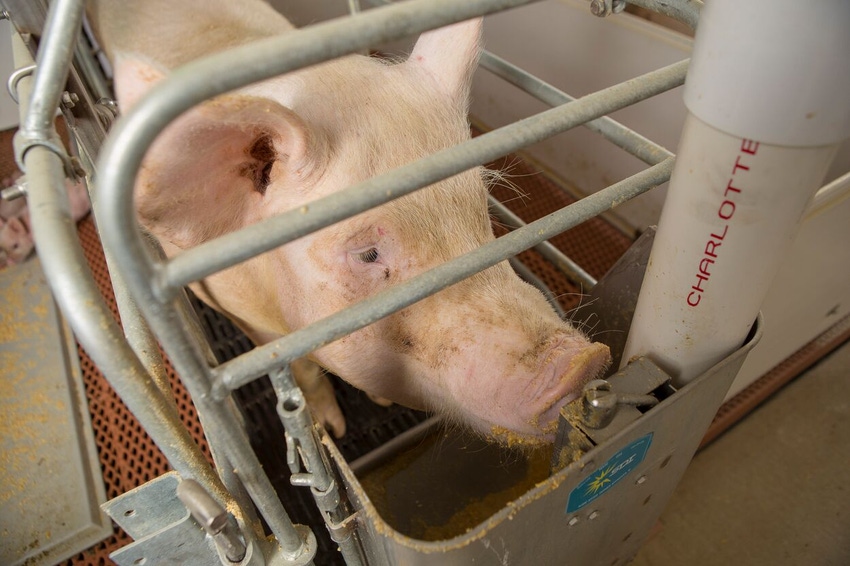Sow lactation feed intake is critical to drive milk production, next litter conception.

Great nursery pig performance begins at the sow farm, more specifically at the mammary line, says Casey Neill.
"Sows are producing a lot of milk. They produce as much milk as a Holstein cow on a live weight basis, and they're weaning larger litters now more than ever," says Neill.
A swine nutritionist with Carthage Veterinary Service, Neill recently spoke about the importance of sow lactation feed intake during the 2023 Banff Pork Seminar. While creep feeding is often suggested in the nursery to help piglets get on feed and to improve weaning weights, Neill says it can be impractical for some production systems to have labor on site creep feeding every crate twice a day. He also points to recent research from Kansas State University (Wensley et al., 2022) that showed sire line maturity may be playing a larger part in feed intake.
"Early maturing genetics, those pigs started better in the nursery. They had less weight loss and therefore it didn't matter if they got creep fed or not," Neill says. "Lifetime performance was the same, but there was an interaction with the late maturing genetics. On the late maturing, if they did get creep fed, they did have a better lifetime average daily gain, better market weight compared to the pigs that did not get creep fed, so there seems to be something going on here with the late maturing genetics."
Instead, Neill suggests focusing on lactation diet formulation to drive milk production and weaning weights. For example, recent research conducted at a Carthage Veterinary Service 6,000-head sow farm with Dr. Laura Greiner, PIC, University of Missouri and Ajinomoto examined the effects of dietary lysine levels on weaning weight. As SID lysine intake increased to 60 grams per day, weaning weights improved while sows lost the least amount of body weight and had the shortest wean-to-estrus interval.
However, lysine is not the only nutrient needed for maximum production and to drive feed intake. The diet also needs to be palatable over time.
Neill highlights recent research from United Animal Health that examined how retention was affected by Parity 1 average daily feed intake. They analyzed over 2,600 sow records to see how Parity 1 gilts ate in first lactation, and how that affected retention to Parity 2, Parity 3, etc.
"When you look at the Parity 2 and Parity 3, you can see the sows or the gilts that ate high levels of feed that first farrowing, their retention into the Parity 2, Parity 3 was the highest," Neill says. "So, since they stayed in the herd better, when they ate better on that Parity 1, you can see lifetime pigs produced increased as feed intake during the parity."
Since the Carthage System feed mill manufactures feed for over 100,000 sows, there is no way the plant can produce a different lactation diet for each of its 28 sow farms. Instead, the pork production system formulates all diets for first parity.
"Our approach is to feed to the younger sow, and so we may be overfeeding," Neill acknowledges. "We're probably feeding higher levels of lysine to the older parities than what they really need or require, but when we're trying to feed to the Parity 1, Parity 2, those sows are going to stay around the herd for another two years at least, hopefully."
They also try to feed the younger gilt diet year-round, however the lysine level may change from winter to summer as feed intake changes. He also points out looking at the average feed intake is not correct for feeding younger sows.
"When we look at the average lactation intake for the farm, we understand that we need to look at it probably 10% below the average at least to really know what the actual intake is of those younger parities," Neill says. "Because we can't in a commercial system break out the P1s versus the P5s on feed intake. So that's why it's a little bit dangerous when I hear people talk about feeding to spec … then they have a Parity 2 dip, and they don't know why."
Production systems need to first understand their current nursery performance before they can set goals. However, Neill says those goals need to be set with the end in mind.
"We understand that weaning weight will help those pigs start on feed that first seven days in the nursery, help reduce mortality," Neill says. "Looking at how those diets are put together and formulated is also very important."
About the Author(s)
You May Also Like





